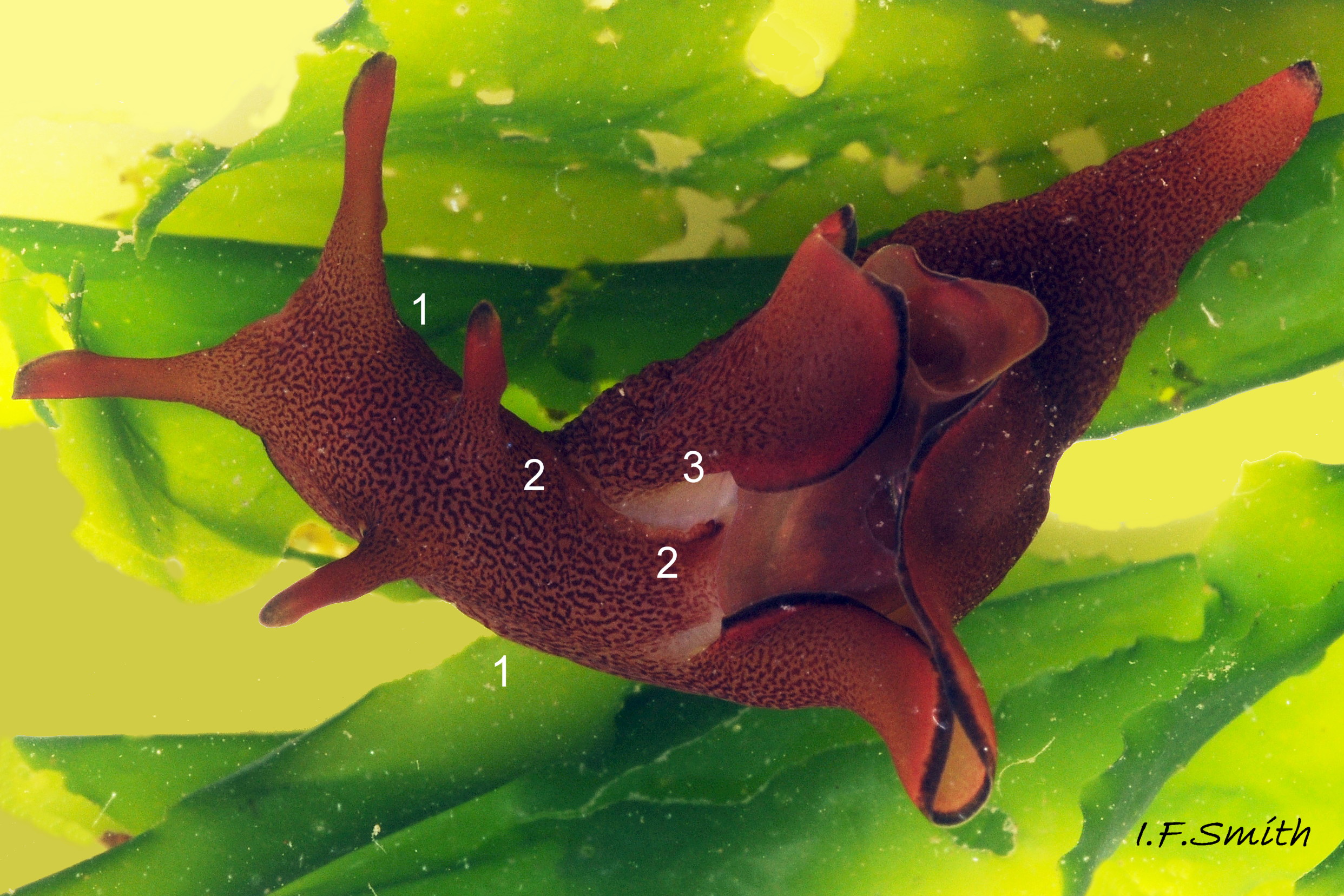Feeding on Ulva.
1: large head and neck.
2-2: seminal groove.
3: unpigmented area near anterior of right parapodial flap is site of opaline gland and, at end of seminal groove, the common genital aperture. Opaline gland excretes milky-white acrid fluid.
marinvert.senckenberg.science/image-browse/
Key identification features
Aplysia punctata
1. Parapodial lobes unite at their posterior to form single parapodium. Area enclosed by parapodium not close to posterior of animal ( in Grigg, 1949) 07 Aplysia punctata. Length 25mm. Flamborough, England. September 2014. Leg. S.Taylor. . Swims rarely, if at all, and clumsily if it does.
2. Foramen 03 Aplysia punctata. Length 25mm. Flamborough, England. September 2014. Leg. S.Taylor. (round hole in mantle that exposes shell) is larger, relative to animal’s size, than foramen on A. depilans or A. fasciata .
3. Full-grown length about 70mm, usual maximum 120mm.
4. Foot occasionally expands into rounded sucker 1 13 Aplysia punctata. Length 25mm. Flamborough, England. September 2014. Leg. S.Taylor. at anterior, but rarely, if ever, at posterior. Sole whitish.
5. Occurs all round Britain except parts of southern N. Sea and north east Irish Sea.
Similar species
Aplysia depilans Gmelin, 1791.
1. Parapodial lobes unite at their posterior to form single parapodium. Parapodial enclosure close to posterior of animal ( in Grigg, 1949) 1 16 Aplysia punctata album. Comparison image of A. depilans; “finger test”. Cornwall, England. December 2014. Leg. D. Fenwick. . Swims rarely, if at all, and clumsily if it does.
2 Foramen is smaller, relative to animal’s size, than foramen on A. punctata
3. Length frequently 120mm or more, up to 300mm.
4. Foot frequently expands at posterior into rounded sucker attached to substrate. Sole brown.
5. In Britain (2015), confined to south west England; breeds in Cornwall.
Aplysia fasciata Poiret, 1789
1. Parapodial lobes do not unite at their posterior to form single parapodium ( in Grigg, 1949) ; frequently used to swim gracefully flic.kr/p/da9ojG (R.Fernandez); www.youtube.com/watch?v=x051Lw6LMBw#t=26 (M.Pontes, video) .
2 Tiny foramen, pore-like on raised papilla (Grigg, 1949), is far smaller, relative to animal’s size, than foramen on A. punctata; often difficult to discern flic.kr/p/5b1pD8 (A.L-A.Cama)
3. Length frequently about 200mm, with weight nearly 2kg, but up to 400 mm (largest British gastropod).
4. Foot pointed at posterior.
5. Reliably recorded from Dorset, South Devon, Cornwall and Channel Islands; rare www.glaucus.org.uk/Aplysia.htm
Aplysia parvula Mörch, 1863,
This species was recorded for Britain (Bebbington & Brown, 1975) on the basis of morphological features of small Aplysia punctata specimens. Recent DNA studies (Golestani et al. 2019) found that A. parvula is confined to the tropical western Atlantic, and no DNA evidence for it was found in specimens examined from the north eastern Atlantic or Mediterranean.

